#EEL
Photo

HEADSHOT windosxp
Headshot completed for windosxp
244 notes
·
View notes
Text

ribbon eel miku :)
#hatsune miku#miku#vocaloid#vocaloid miku#miku fanart#miku verse#eel#ribbon eel#art#my art#artists on tumblr
14K notes
·
View notes
Text
Snipe eel is the perfect name for that thing
#snipe eel#snipe#eels#aquarium#marine biology#fish#oceanposting#deep sea#sea creatures#ocean#sea life#marine life#marine biology memes#fishblr#eel
14K notes
·
View notes
Text
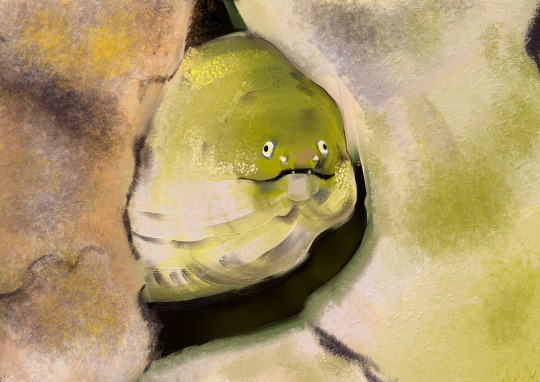
May I offer you an eel in these trying times?
17K notes
·
View notes
Text

MUSIC FOR EELS!!
#eel#Music for Eels#art#digital art#drawing#fish#marine life#study#art study#digital painting#painting#headphones#animal
4K notes
·
View notes
Text

Help the unfortunate eel...😰
#art#мой арт#artists on tumblr#twst#twisted wonderland#twst jade#jade twisted wonderland#jade leech#jade leech twst#eel#jade leech eel#moray eels
3K notes
·
View notes
Text
Playable character prototype for work!
3K notes
·
View notes
Text

thinking about these guys again
1K notes
·
View notes
Text
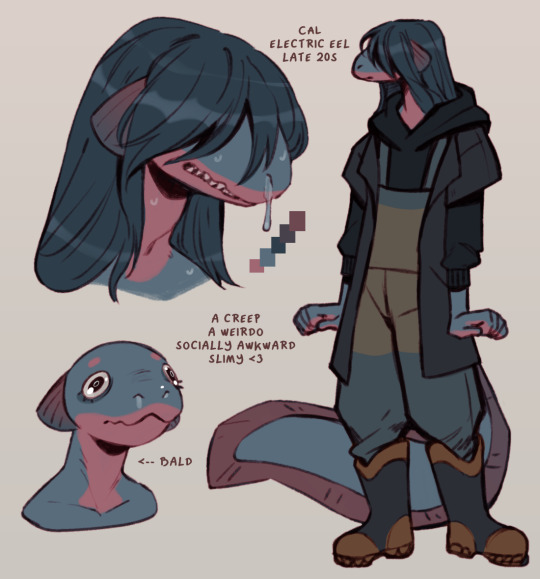
new lil loser guy.... cal :3
5K notes
·
View notes
Text
trans people: im trans
society: ok
moray eel: 😐😮😐😮😐😮😐😮😐😮😐😮😐
17K notes
·
View notes
Text
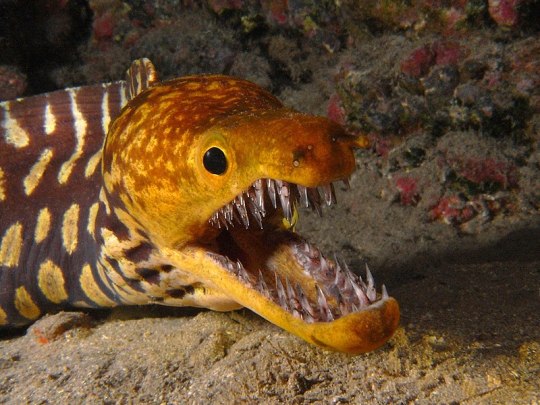
Fangtooth Moray Eel 🪸 [x]
7K notes
·
View notes
Text

Jade's worst nightmare 🌊
That's definitely the most detailed illustration I've ever drawn and it also took me a while to finish it. I procrastinated because I was going out of my comfort zone and I was so scared to mess it up... but I overcame it because the lore behind this drawing meant a lot to me.
About this illustration, I wanted to focus on Jade's sensitivity through the world surrounding him, especially on land. I wanted to break the twisted picture we all have of him and show his vulnerability. I also wanted to express a duality between his sea life and life on land. His eel form is a reminder of where he originally comes from.
To me, Jade looks like an unbreakable wall: he basically smiles all the time and he always seems to hide his true emotions. Although Jade tends to do some questionable things (let’s be real), I do believe that behind that wall, there’s an unusual but very touching sensitivity.
What I adore about Jade is the fact that he doesn't fear people's opinion about his hobbies and nothing can stop him from doing them, no matter what. He has a deep connection to everything related to nature so to me, he enjoys quiet places and being alone. Therefore I strongly believe he's an introvert and needs those moments disconnected from any social interactions.
Even though Jade appreciates solitude, he also needs to connect with people from time to time. There was a sentence he said during Vargas Camp that literally broke my heart:
"I'm envious that everyone else has someone to converse with. And here I am, all alone."
To me, that proves he's actually looking for deep connections with people so that he can be himself without being judged at all. Even Floyd and Azul find his interests weird and they're pretty harsh about his club. I know the octatrio has their own dynamics but still, Jade deserves to have a buddy who shares the same hobbies as him.

Anyway, I could write so much more about Jade but that's basically how I see him. My interpretation is probably a bit biased because of the love I already have for him but whatever. Thanks to it, I was able to imagine what could be his worst fear as he always seems so untouchable at first sight. I love shady Jade but sensitive Jade is what I need right now.
#twisted wonderland#twst#jade leech#twst jade#octavinelle#floyd leech#ツイステ#twstファンアート#ツイステファンアート#mermay#twst fanart#twisted wonderland fanart#disney twisted wonderland#twst disney#twst wonderland#disney fanart#disney twst#twst jp#twst english#fanart#fanarts#merman#eel#merfolk#illustration#artists on tumblr#digital art#my art#artjiayi
1K notes
·
View notes
Text



Wet beasts take on a modeling job

version without the water
902 notes
·
View notes
Text
Wet Beast Wednesday: moray eels
This week on Wet Beast Wednesday I'll be going over something amazing, a fish with a sense of morality. You see, the moral eel is known for, what... I think I'm reading this wrong. Oh, MoRAY eel, not moral. Well this is awkward. Hang tight, I need to go redo my research.

(Image: a green moray (Gymnothorax funebris) swimming outside of its burry, with its whole body visible from the side. It is a long, slender fish that looks a bit like a snake. A long fin starts just below the head and continues down the length of the body. The body is arranged in a wave pattern. It has a pointed snout and small eyes. Its body is a yellow-green color. In the background is the sandy seafloor, dotted with various sponges and corals. End ID)
Moray eels are true eels, meaning they are in the order Anguiliformes. Yeah, I did wolf eels, electric eels, and lamprey eels before I got around to actual eels. There are over 200 known species of moray eel in 15 genera. Like other eels, they are elongated bony fish with extra vertebrae and reduced fins. Moray eels have fewer fins than most eel species, only having a dorsal, anal and tail fin that merge together and run down the back of most of the body and underneath portion of it. They achieve motion by undulating this long fin and sometimes undulating the rest of the body as well. Moray eels aren't the fastest of fish, but they can swim backwards, something almost no fish can. The head has a long snout with wide jaws. Most species have long fangs used to grab onto prey, but a few species are adapted to eat hard-shelled prey and have molar-like teeth to crush through shells instead. Probably the coolest feature of morays are the pharyngeal jaws. This is a second set of jaws located in the back of the mouth. When the eel bites onto prey, the jaws can be shot forward to grab the food and help pull it into the throat. While lots of fish have pharyngeal jaws, morays are the only ones who can extend their pharyngeal jaws forward and use them to grab prey. Morays have smooth, scaleless skin that is often patterned to provide camouflage. The skin is coated in mucus that provides protection from damage and infection. In some species, the mucus can be used to glue sand together to help reinforce burrows. Morays lack lateral lines, a system of organs found in most fish that senses changes in water movement. Their sense of smell is their primary sense. The size of morays varies between species. The smallest species is the dwarf moray eel (Gymnothorax melatremus) which reaches 26 cm (10 in) long. The largest species by mass is the giant moray eel (Gymnothorax javanicus) which can reach 3 meters (10 ft) and 30 kg (66 lbs) while the longest species is the slender giant moray (Strophidon sathete), the longest known specimen of which measured in at 3.94 m (12.9 ft).

New reaction image
(Image: a giant moray (Gymnothorax javanicus) emerging from a burrow. It is brown and mottled with yellowish patches. Its head is pointed at the camera and it's mouth is wide open, aming it look shocked. End ID)

(Image: an anatomical diagram of the skeleton of a moray eel emphasizing the pharyngeal jaws and the muscle attachments. End ID. Art by Zina Deretsky)
Moray eels are found throughout the Atlantic, Pacific, and Indian oceans. Different species are found in different temperatures and depths, though most species live in relatively shallow, warm water. Several species can live in brackish water and a few will swim upriver and live for a time in fresh water, though there do not appear to be any species that live their entire lives in fresh water. Morays are ambush predators who rely on the element of surprise. They live in small, tight places such as holes in coral, gaps between rocks, or sandy burrows. When prey passes, the eel can lunge out and grab it. Unlike most fish, the eel cannot use suction feeding due to the shapes of their mouths. They have to rely on lunging froward and catching prey with their mouths. Their mouths are adapted in shape to push water to the sides. This reduces water resistance and avoids creating a wave that could push prey away from the eel. If an eel catches prey that cannot be swallowed whole, it will tie itself in a knot while biting on to the food. By pulling its head through the loop, the eel can rip the food into bite-sized pieces. Spending most of their times in burrows also provides protection from predators, especially in juveniles or smaller species. At night, the eels will come out of their burrows to hunt sleeping prey while the larger predators are asleep. Giant morays have also been seen engaging in interspecies cooperative hunting with roving coral groupers (Plectropomus pessuliferus). The eels can fit into small crevices the groupers can't to flush prey into the grouper's path while catching their own. Morays are mostly solitary species and many can be territorial. They are known to be shy and will retreat into their burrows if they feel threatened. They are also curious and many species are quite intelligent.
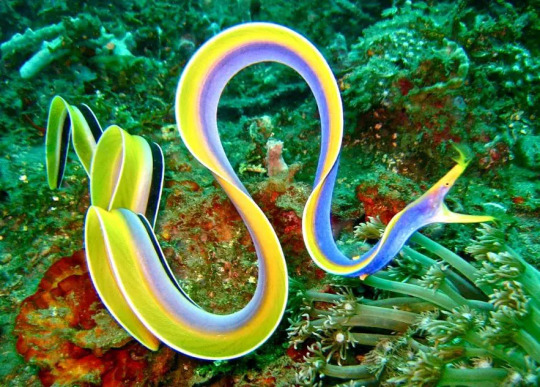
(Image: a male ribbon eel (Rhinomuraena quaesita) on a coral reef. It is a very long and slender eel with its body curved in many waves. It is brightly colored, with a blue-purple body, yellow fin and face, and a long black and white stripe running down the back half of the body. On the nostrils are two feather-like structures. End ID)
Morays reproductive strategies are poorly known and differ based on species. While many species seem to have no set mating season and will reproduce whenever they can, others will mate at the same time every year. Some species seem to have dedicated spots to lay their eggs and a few are believed to be anadromous, meaning they travel from the sea to fresh water to spawn. Meanwhile, some of the species that spend a lot of time in fresh water are catadromous, meaning they return to sea to mate. Females will lay their eggs and the male fertilize them. After this, they depart, providing no parental care. As with all true eels, moray eels begin life as leptocephalus larvae. This type of fish larvae is notable for its resemblance to a simple, transparent leaf with a head on one end. These larvae are unique and poorly understood, despite being the larval stage of a lot of different species of fish. They are unusually well developed for larvae, capable of active swimming and generally living life. In fact, some particularly large leptocephalus larvae were initially mistaken for adult fish. They feed mostly on bits of drifting organic material called marine snow and can remain in the larval stage for up to 3 years, with those in colder conditions usually taking longer to metamorphose. All leptocephalus larvae start out with no sex organs, then develop female organs, then develop male ones, becoming simultaneous hermaphrodites. They will ultimately become eith male or female and it is likely that environmental factors are the main determining factor. During metamorphosis into a juvenile, the leptocephalus can reduce in size by up to 90%, resulting in the juvenile being smaller than the larva. The process of maturation is poorly understood, but it seems that most morays will be sexually mature by three years of age.

(Image: multiple photos of a particularly large leptocephalus larva (not sure what species). It is a translucent organis, wth a body shaped like a very long leaf, narrow at both ends. In the frint is a very tiny head. End ID)
Morays are shy and generally avoid humans. Though some cultures have hunted them for food, they are often not considered a particularly good food source. Many species have high levels of chemicals called ciguatoxins in their bodies, which can lead to a condition called ciguatera fish poisoning if eaten. The largest threat to morays is habitat loss. This is especially true for the many species that live in coral reefs, which are in increasing danger due to global warming. Attacks on humans are rare and usually happen as a response to a human sticking their hand in the eel's burrow. Some of the large species could cause significant damage with a bite. Some species, usually the smaller ones, are found in the aquarium trade, thought they are not good pets for beginners as even the smallest morays are still large for aquarium fish and have some specific requirements. The curiosity many morays have has led to some becoming familiar with and even friendly to humans, often the result of feeding them. They can recognize individual humans and remember them over the course of years. Aquarium employees sometimes report that the eels will come to nuzzle and play with them and have personalities like dogs. Marine biologists and professional SCUBA divers Ron and Valorie Taylor befriended a pair of eels they named Harry and Fang at the Great Barrier Reef who would remember them and come out to visit them year after year.
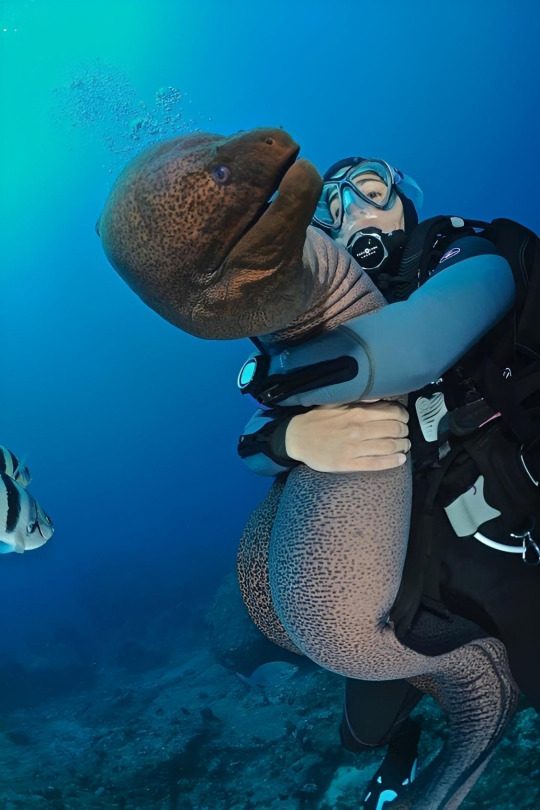
(Image: a SCUBA diver hugging a large, brown moray with black spots. End ID)
youtube
(Video: A shot video showing Valeria Taylor and a moray eel she befriended)
youtube
(Video: the song "That's a Moray", a parody of the song "That's Amore" by Dean Martin)
#wet beast wednesday#i accidentally typed moron eel more than once#moray eel#eel#anguiliformes#fish#bony fish#fishblr#fishposting#eelposting#marine biology#biology#ecology#zoology#animal facts#informative#image described#that's a moray#educational#Youtube
1K notes
·
View notes
Text

GARDEN EEL
958 notes
·
View notes
